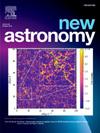A critical reanalysis of supernova type Ia data
IF 2.1
4区 物理与天体物理
Q2 ASTRONOMY & ASTROPHYSICS
引用次数: 0
Abstract
Cosmological parameter fitting remains crucial, especially with the abundance of available data. While many parameters have been tightly constrained, discrepancies — most notably the Hubble tension — persist between measurements obtained from different observational datasets. In this paper, we re-examine the Pantheon supernova dataset to explore deviations in the distribution of distance modulus residuals from the Gaussian distribution, which is typically the underlying assumption. We do this analysis for the concordant cosmological constant model and for a variety of dynamical dark energy models. It has been shown earlier that the residuals in this dataset are better fit to a logistic distribution. We compare the residual distributions assuming both Gaussian and Logistic likelihoods on the complete dataset, as well as various subsets of the data. The results, validated through various statistical tests, demonstrate that the Logistic likelihood provides a better fit for the full dataset and lower redshift bins, while higher redshift bins fit Gaussian and Logistic likelihoods similarly. Furthermore, the findings indicate a preference for a cosmological constant model. However analysing individual surveys within the Pantheon dataset reveals inconsistencies among subsets. The level of agreement between surveys varies depending upon the underlying likelihood function.
Ia型超新星数据的关键再分析
宇宙学参数拟合仍然至关重要,尤其是在现有数据丰富的情况下。虽然许多参数都受到严格的限制,但从不同观测数据集获得的测量结果之间的差异——最明显的是哈勃张力——仍然存在。在本文中,我们重新检查了Pantheon超新星数据集,以探索距离模量残差分布与高斯分布的偏差,这是典型的基本假设。我们对调和宇宙学常数模型和各种动态暗能量模型进行了分析。前面已经表明,该数据集中的残差更适合逻辑分布。我们比较了在完整数据集上假设高斯似然和逻辑似然的残差分布,以及数据的各个子集。通过各种统计测试验证的结果表明,Logistic似然对完整数据集和低红移箱提供了更好的拟合,而高红移箱同样适合高斯似然和Logistic似然。此外,这些发现表明人们更倾向于宇宙学常数模型。然而,分析万神殿数据集内的个别调查揭示了子集之间的不一致性。调查之间的一致程度取决于潜在的可能性函数。
本文章由计算机程序翻译,如有差异,请以英文原文为准。
求助全文
约1分钟内获得全文
求助全文
来源期刊

New Astronomy
地学天文-天文与天体物理
CiteScore
4.00
自引率
10.00%
发文量
109
审稿时长
13.6 weeks
期刊介绍:
New Astronomy publishes articles in all fields of astronomy and astrophysics, with a particular focus on computational astronomy: mathematical and astronomy techniques and methodology, simulations, modelling and numerical results and computational techniques in instrumentation.
New Astronomy includes full length research articles and review articles. The journal covers solar, stellar, galactic and extragalactic astronomy and astrophysics. It reports on original research in all wavelength bands, ranging from radio to gamma-ray.
 求助内容:
求助内容: 应助结果提醒方式:
应助结果提醒方式:


